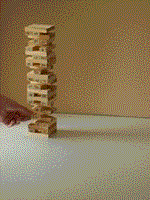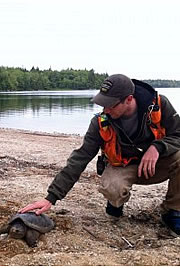The Jenga theory of biodiversity: The tipping point of ecosystems and the diversity of species
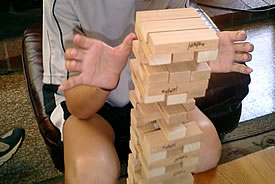
Jenga tower (Photo by Wikimedia Commons, Derek Mawhinney and Cafe Nervosa)
A while back I was a guest on the CBC Radio program, Shift New Brunswick to speak about the discovery of a little flowering plant— one of the rarest in my home province and a federally listed species at risk. You most likely may not have heard of it before: Van Brunt’s Jacob’s Ladder (or Polemonium vanbruntiae as Mr. Linnaeus would have lovingly called it). Not being a particularly showy flower, and one that grows in swampy areas that aren’t especially pleasant to slog through, it could quite easily be overlooked. Although beautiful in its own right to anyone who is inclined towards floristic pursuits, it probably won’t be making the cover of Vogue Botanica anytime soon.
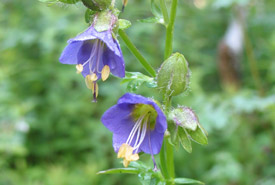
Van Brunt's Jacob's-Ladder (Photo by Stephen Clayden)
So interviewer Christine McLean asked questions about what it looks like, where it grows, how it was discovered, etcetera; all questions that had relatively easy answers. Toward the end of the interview however, I was asked, “What are the benefits of having it (the plant) around?”
I floundered for an answer. Not because I didn’t have one, but because I needed to sum up some pretty big concepts that I had never needed to sum up before. Protecting biodiversity is important to many people for many different reasons, but is there really a central reason why the average Joe and Jane should actually care? I think so.
With only 20 seconds left of a roughly seven-minute interview, I ended up using a metaphor of Jenga — that surprisingly simple game that gives you just enough anxiety to make it fun. I described how each species can be seen as a block in the tower. If you take a block out (representing species extinction) it might not make the tower fall, but it does make it weaker. Every block removed increases the chances of the tower collapsing by taking away the support of the blocks that remain, and also by shifting the balance of the tower as a whole.
After a while it doesn’t take much to knock the whole thing down. The final blow might be the removal of that all-important block, or it might be caused by outside forces — a wobbly table, a heavy breather, or maybe just a fault in one of the blocks that went unnoticed. The resilience of the Jenga tower becomes increasingly compromised, and everyone sitting around the table knows that someone will eventually be responsible for a disorderly pile of blocks (amidst squeals of delighted laughter by those that aren’t responsible, of course).
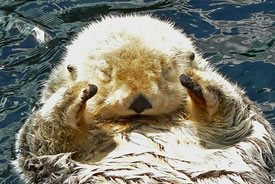
Sea otter, Vancouver Aquarium (Photo by Wikimedia Commons, Stan Shebs)
Probably the most well known “block” relevant to the topic of biodiversity is the sea otter. The “tower” that the Sea otter supported was the kelp forest ecosystem of pacific North America. After being driven close to extinction by early European explorers, the lack of sea otters allowed sea urchins, their favourite food, to explode in numbers, which in turn caused the disappearance of the kelp forests. Sea urchins munched these kelp beds into oblivion since the otters weren’t around to control the urchin population, which then resulted in the disappearance of all the other marine life that depended on the kelp beds as habitat, from shrimp to whales.
We know this because fortunately, remnant populations of sea otters were discovered before it was too late, and the impacts of their reintroduction to their natural habitat were recorded. After putting the otters back, the rich kelp forest ecosystem with all its diversity of creatures began to return (albeit slowly), including those that are commercially important for people (we’re just another block, after all).
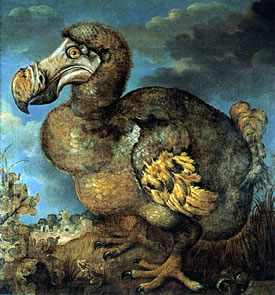
Dodo (Painting by Jan Savery, circa 1589-1654)
On the island of Mauritius in the Indian Ocean, previously home to the infamous dodo bird, there was once a species of 600-pound tortoise. The story goes that when Dutch sailors first arrived on the island in 1638 there were so many tortoises that they could walk exclusively on the turtles' backs without touching the ground (a bit of a stretch most likely, but you get the idea). Then they ate them all — every last one.
The extinction did not seem to have any obvious impacts on the surrounding ecosystem, until in the 1970s researchers began to notice that the native tree species (which can live for centuries) were not reproducing and were becoming threatened by extinction. If the trees were lost, so would be the insect pollinators, the birds that fed on their foliage, the bats that roosted in their branches and the orchids that grew in their canopies.
After some frantic research, it turned out those trees needed their fruit to pass through the gut of a tortoise in order to germinate. No tortoise, no trees. In a desperate and controversial attempt to reverse the decline, a similar species of tortoise was relocated from a nearby island with some promising results. Although there are still no guarantees of success due to the unknowns surrounding the ecology of both the tortoise and the tree species, it goes to show how the removal of a seemingly unnecessary block could have huge repercussions down the road.
Whether the impacts of extinction happen right away or centuries later, they will undoubtedly happen. No species stands alone, and the loss of one will always have some form of impact on others, often in a chain reaction.
We’ve only scratched the surface of discovering the interconnectedness within ecosystems; in many cases we know nothing at all. What we do know however, is that at the end of the day resilient ecosystems — those that are best suited to remain stable and continuously provide us with goods and services — are the ones that maintain their full diversity.
As Aldo Leopold has been cited time and again, “To keep every cog and wheel is the first precaution of intelligent tinkering.”
So what would happen if good ‘ol Polemonium vanbruntiae were to bite the proverbial dust? The answer is that we have no idea — but it’s not going to do any good if it’s gone. So let’s hedge our bets.

